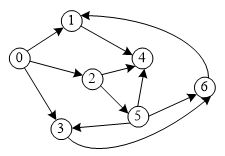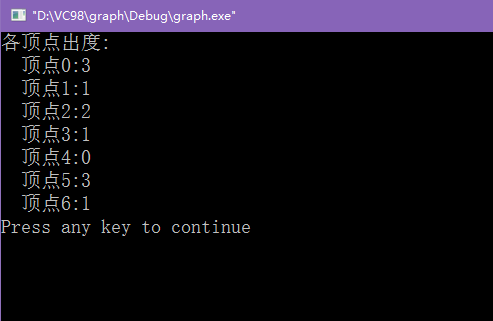- /*
- Copyright (c)2016,烟台大学计算机与控制工程学院
- All rights reserved.
- 文件名称:第十二周项目3 - 图遍历算法实现.cpp
- 作 者:朱建豪
- 完成日期:2016年11月18日
- 版 本 号:v1.0
- 问题描述: 实现图遍历算法,分别输出如下图结构的深度优先(DFS)遍历序列和广度优先遍历(BFS)序列。
- 输入描述:若干测试数据。
- 程序输出:DFS,BFS的遍历序列。
- */

(1)输出出图G中每个顶点的出度
代码:
- #include "graph.h"
- //返回图G中编号为v的顶点的出度
- int OutDegree(ALGraph *G,int v)
- {
- ArcNode *p;
- int n=0;
- p=G->adjlist[v].firstarc;
- while (p!=NULL)
- {
- n++;
- p=p->nextarc;
- }
- return n;
- }
- //输出图G中每个顶点的出度
- void OutDs(ALGraph *G)
- {
- int i;
- for (i=0; i<G->n; i++)
- printf(" 顶点%d:%d\n",i,OutDegree(G,i));
- }
- int main()
- {
- ALGraph *G;
- int A[7][7]=
- {
- {0,1,1,1,0,0,0},
- {0,0,0,0,1,0,0},
- {0,0,0,0,1,1,0},
- {0,0,0,0,0,0,1},
- {0,0,0,0,0,0,0},
- {0,0,0,1,1,0,1},
- {0,1,0,0,0,0,0}
- };
- ArrayToList(A[0], 7, G);
- printf("各顶点出度:\n");
- OutDs(G);
- return 0;
- }
(2)求出图G中出度最大的一个顶点,输出该顶点编号
代码:
- #include "graph.h"
- //返回图G中编号为v的顶点的出度
- int OutDegree(ALGraph *G,int v)
- {
- ArcNode *p;
- int n=0;
- p=G->adjlist[v].firstarc;
- while (p!=NULL)
- {
- n++;
- p=p->nextarc;
- }
- return n;
- }
- //输出图G中每个顶点的出度
- void OutDs(ALGraph *G)
- {
- int i;
- for (i=0; i<G->n; i++)
- printf(" 顶点%d:%d\n",i,OutDegree(G,i));
- }
- //输出图G中出度最大的一个顶点
- void OutMaxDs(ALGraph *G)
- {
- int maxv=0,maxds=0,i,x;
- for (i=0; i<G->n; i++)
- {
- x=OutDegree(G,i);
- if (x>maxds)
- {
- maxds=x;
- maxv=i;
- }
- }
- printf("顶点%d,出度=%d\n",maxv,maxds);
- }
- int main()
- {
- ALGraph *G;
- int A[7][7]=
- {
- {0,1,1,1,0,0,0},
- {0,0,0,0,1,0,0},
- {0,0,0,0,1,1,0},
- {0,0,0,0,0,0,1},
- {0,0,0,0,0,0,0},
- {0,0,0,1,1,0,1},
- {0,1,0,0,0,0,0}
- };
- ArrayToList(A[0], 7, G);
- printf("最大出度的顶点信息:");
- OutMaxDs(G);
- return 0;
- }
(3)计算图G中出度为0的顶点数;
代码:
- #include "graph.h"
- //返回图G中编号为v的顶点的出度
- int OutDegree(ALGraph *G,int v)
- {
- ArcNode *p;
- int n=0;
- p=G->adjlist[v].firstarc;
- while (p!=NULL)
- {
- n++;
- p=p->nextarc;
- }
- return n;
- }
- //输出图G中每个顶点的出度
- void OutDs(ALGraph *G)
- {
- int i;
- for (i=0; i<G->n; i++)
- printf(" 顶点%d:%d\n",i,OutDegree(G,i));
- }
- //输出图G中出度为0的顶点数
- void ZeroDs(ALGraph *G)
- {
- int i,x;
- for (i=0; i<G->n; i++)
- {
- x=OutDegree(G,i);
- if (x==0)
- printf("%2d",i);
- }
- printf("\n");
- }
- int main()
- {
- ALGraph *G;
- int A[7][7]=
- {
- {0,1,1,1,0,0,0},
- {0,0,0,0,1,0,0},
- {0,0,0,0,1,1,0},
- {0,0,0,0,0,0,1},
- {0,0,0,0,0,0,0},
- {0,0,0,1,1,0,1},
- {0,1,0,0,0,0,0}
- };
- ArrayToList(A[0], 7, G);
- printf("出度为0的顶点:");
- ZeroDs(G);
- return 0;
- }
(4)判断图G中是否存在边 <i,j>
代码:
- <nobr>#include "graph.h"
- //返回图G中编号为v的顶点的出度
- int OutDegree(ALGraph *G,int v)
- {
- ArcNode *p;
- int n=0;
- p=G->adjlist[v].firstarc;
- while (p!=NULL)
- {
- n++;
- p=p->nextarc;
- }
- return n;
- }
- //输出图G中每个顶点的出度
- void OutDs(ALGraph *G)
- {
- int i;
- for (i=0; i<G->n; i++)
- printf(" 顶点%d:%d\n",i,OutDegree(G,i));
- }
- //输出图G中出度最大的一个顶点
- void OutMaxDs(ALGraph *G)
- {
- int maxv=0,maxds=0,i,x;
- for (i=0; i<G->n; i++)
- {
- x=OutDegree(G,i);
- if (x>maxds)
- {
- maxds=x;
- maxv=i;
- }
- }
- printf("顶点%d,出度=%d\n",maxv,maxds);
- }
- //输出图G中出度为0的顶点数
- void ZeroDs(ALGraph *G)
- {
- int i,x;
- for (i=0; i<G->n; i++)
- {
- x=OutDegree(G,i);
- if (x==0)
- printf("%2d",i);
- }
- printf("\n");
- }
- //返回图G中是否存在边<i,j>
- bool Arc(ALGraph *G, int i,int j)
- {
- ArcNode *p;
- bool found = false;
- p=G->adjlist[i].firstarc;
- while (p!=NULL)
- {
- if(p->adjvex==j)
- {
- found = true;
- break;
- }
- p=p->nextarc;
- }
- return found;
- }
- int main()
- {
- ALGraph *G;
- int A[7][7]=
- {
- {0,1,1,1,0,0,0},
- {0,0,0,0,1,0,0},
- {0,0,0,0,1,1,0},
- {0,0,0,0,0,0,1},
- {0,0,0,0,0,0,0},
- {0,0,0,1,1,0,1},
- {0,1,0,0,0,0,0}
- };
- ArrayToList(A[0], 7, G);
- printf("边<2,6>存在吗?");
- if(Arc(G,2,6))
- printf("是\n");
- else
- printf("否\n");
- printf("\n");
- return 0;
- } </nobr>
知识点总结:
图算法的应用。

























 被折叠的 条评论
为什么被折叠?
被折叠的 条评论
为什么被折叠?








